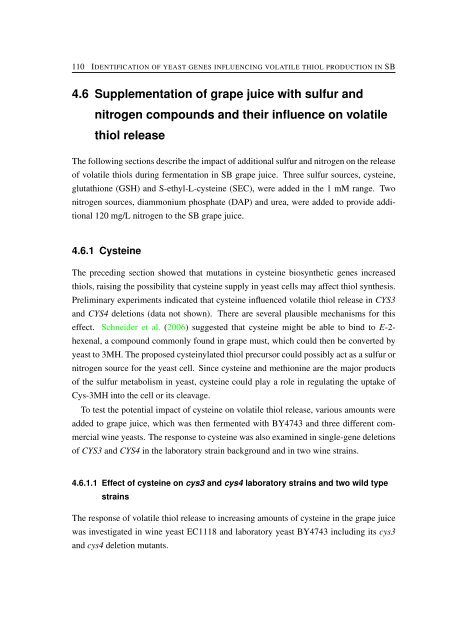Identification of yeast genes involved in Sauvignon Blanc aroma ...
Identification of yeast genes involved in Sauvignon Blanc aroma ...
Identification of yeast genes involved in Sauvignon Blanc aroma ...
Create successful ePaper yourself
Turn your PDF publications into a flip-book with our unique Google optimized e-Paper software.
110 IDENTIFICATION OF YEAST GENES INFLUENCING VOLATILE THIOL PRODUCTION IN SB4.6 Supplementation <strong>of</strong> grape juice with sulfur andnitrogen compounds and their <strong>in</strong>fluence on volatilethiol releaseThe follow<strong>in</strong>g sections describe the impact <strong>of</strong> additional sulfur and nitrogen on the release<strong>of</strong> volatile thiols dur<strong>in</strong>g fermentation <strong>in</strong> SB grape juice. Three sulfur sources, cyste<strong>in</strong>e,glutathione (GSH) and S-ethyl-L-cyste<strong>in</strong>e (SEC), were added <strong>in</strong> the 1 mM range. Twonitrogen sources, diammonium phosphate (DAP) and urea, were added to provide additional120 mg/L nitrogen to the SB grape juice.4.6.1 Cyste<strong>in</strong>eThe preced<strong>in</strong>g section showed that mutations <strong>in</strong> cyste<strong>in</strong>e biosynthetic <strong>genes</strong> <strong>in</strong>creasedthiols, rais<strong>in</strong>g the possibility that cyste<strong>in</strong>e supply <strong>in</strong> <strong>yeast</strong> cells may affect thiol synthesis.Prelim<strong>in</strong>ary experiments <strong>in</strong>dicated that cyste<strong>in</strong>e <strong>in</strong>fluenced volatile thiol release <strong>in</strong> CYS3and CYS4 deletions (data not shown). There are several plausible mechanisms for thiseffect. Schneider et al. (2006) suggested that cyste<strong>in</strong>e might be able to b<strong>in</strong>d to E-2-hexenal, a compound commonly found <strong>in</strong> grape must, which could then be converted by<strong>yeast</strong> to 3MH. The proposed cyste<strong>in</strong>ylated thiol precursor could possibly act as a sulfur ornitrogen source for the <strong>yeast</strong> cell. S<strong>in</strong>ce cyste<strong>in</strong>e and methion<strong>in</strong>e are the major products<strong>of</strong> the sulfur metabolism <strong>in</strong> <strong>yeast</strong>, cyste<strong>in</strong>e could play a role <strong>in</strong> regulat<strong>in</strong>g the uptake <strong>of</strong>Cys-3MH <strong>in</strong>to the cell or its cleavage.To test the potential impact <strong>of</strong> cyste<strong>in</strong>e on volatile thiol release, various amounts wereadded to grape juice, which was then fermented with BY4743 and three different commercialw<strong>in</strong>e <strong>yeast</strong>s. The response to cyste<strong>in</strong>e was also exam<strong>in</strong>ed <strong>in</strong> s<strong>in</strong>gle-gene deletions<strong>of</strong> CYS3 and CYS4 <strong>in</strong> the laboratory stra<strong>in</strong> background and <strong>in</strong> two w<strong>in</strong>e stra<strong>in</strong>s.4.6.1.1 Effect <strong>of</strong> cyste<strong>in</strong>e on cys3 and cys4 laboratory stra<strong>in</strong>s and two wild typestra<strong>in</strong>sThe response <strong>of</strong> volatile thiol release to <strong>in</strong>creas<strong>in</strong>g amounts <strong>of</strong> cyste<strong>in</strong>e <strong>in</strong> the grape juicewas <strong>in</strong>vestigated <strong>in</strong> w<strong>in</strong>e <strong>yeast</strong> EC1118 and laboratory <strong>yeast</strong> BY4743 <strong>in</strong>clud<strong>in</strong>g its cys3and cys4 deletion mutants.














